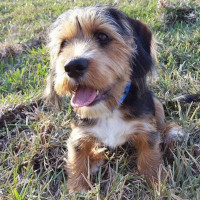Appearance of the Corkie
|
| A medium-sized dog, a well-mannered Corkie is a good family companion. Both parent breeds have silky, straight coats. The main question with their offspring is how long the coat will grow. In reality, the hair tends to be medium to long, stiff and soft to the touch. As the Yorkshire is traditionally black and tan, it's the Cocker side of the family that offers the greatest diversity of colors. Indeed, Corkies can be: roan blue, tan, red and white, red, black, black and white, silver and a range of intermediate shades. Corkies can have straight or floppy ears, depending on which parent they prefer. They have a reasonably long muzzle, with a black leather nose. Their body shape is generally well proportioned to their legs, with a slightly stocky lean. The tail is of medium length and feathered. |
Temperament of the Corkie
|
| The Corkie is a classic case of producing what you're looking for. These dogs are small and cute, but they also have sensitive souls. This means they're less tolerant than dogs and feel threatened. Unfortunately, their reaction to anxiety can be rapid, as a way of protecting themselves. To counter this tendency, you need to start young, with the breeder socializing the puppies while staying with the mother. In the future, the new owner must make a concerted effort to continue exposing the puppy, in a positive way, to a variety of new sights, sounds and smells. Then, as an adult dog, the work of building self-confidence continues. This is done through positive training methods, which allow the dog to remain in control and fearless. In turn, this reduces anxiety and the urge to break. Another aspect of Corkie's character is his built-in prey drive, which goes back to his parental heritage. This can make them unreliable around other pets, so supervision is necessary at all times. |
Needs and activities of the Corkie
|
| The Corkie can become lazy and even overweight if not active on a daily basis. They need at least 45 to 60 minutes of vigorous exercise every day to stay healthy and happy. Without enough exercise, your Corkie can become anxious and bored, which can cause behavioral problems. You can take your Corkie for a walk around the neighborhood, a hike in the park, a long game of fetch, a trip to the dog park or even agility training. If you have a private fenced yard, you can let your Corkie play outside for an hour or two, but they also need mental stimulation and attention. |
Maintenance of the Corkie
|
| Grooming of this hybrid is moderate to high. Their long, silky fur is sensitive to matting and needs to be brushed daily. Many owners have their Corkies groomed every four to six months to make them easier to care for. A stiff bristle brush and a metal comb are needed, as well as a smoother brush for finishing. You should use your fingers to untangle knots so as not to damage their coat. They need their nails trimmed every two or three weeks, and you should clean their ears once a week and check for redness, wax build-up and mites. In addition, brushing their teeth with a soft toothbrush several times a week will help prevent dental problems. |









 English (United Kingdom)
English (United Kingdom)